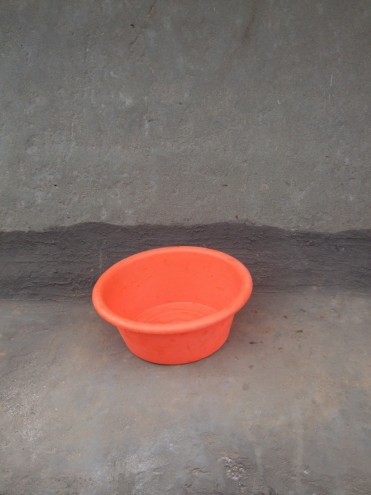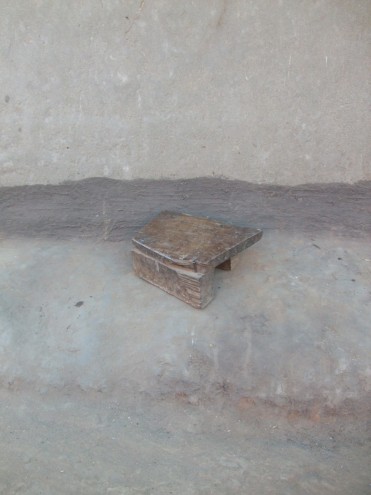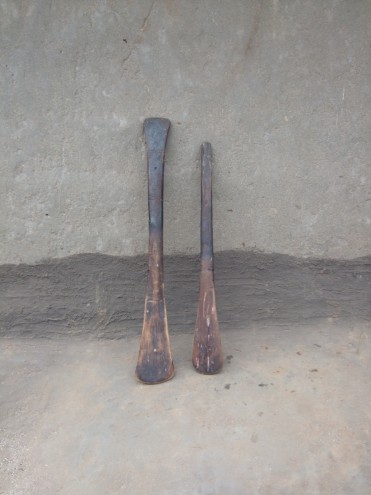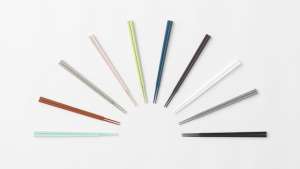From the Series
Reny van der Kamp was so moved by an article on the hardships of a village in Malawi that she decided to do something tangible about it. For the past 6 years she has been travelling to the village of Dickisoni where she has been involved in various projects to help and empower the community including designing a blanket that doubles up as a stool, establishing a foundation through which agriculture skills were taught and starting a knitting circle for the women. Through this work she met and became close friends with Anna and Isim, a couple whose possessions she documents in her new book, Utensils.
What is your background?
I'm a stylist and textile designer. I also work for design companies in the phase of concept strategies. Currently most of my assignments concern developing concepts for sustainable thinking, teaching visual communication and humanitarian design (which I did for the Design Academy in Eindhoven). My own textile collection is 'slow design'; handmade and rooted in traditional crafts, mostly knitting. As a designer I have a strong love for archetypical design: simple forms, useful, natural materials and traditions taken into contemporary designs.
In the book it seems that you became part of the family's daily life, working and living alongside them. Why was this important for you as part of the documentation?
The life I live when I'm there is roughly the same as theirs; rhythm, food, bathing, long walks. But we are sitting on chairs, and most families don't own chairs. They are collected throughout the village for us and our visitors. Also the plates we eat from are collected from different families, for a family meal here is usually eaten from the same bowl by all members. But we receive a plate each, and for me especially some cutlery is on the table.
Through my wonderful translator we can have a conversation. They are very curious, and no subject is taboo. Whether in a group or as individuals, especially the women are eager to exchange stories. But equally important: we also have a lot of fun. We dance, we work together, we laugh about each others stories, our differences in looking at beauty or attraction for instance. Also with the children it's amazing how well we communicate and how many games and dances we can exchange.
Each time I come back there is a deeper understanding. Of what life means for them, how the relationship with these people influences me and through me the people around me here back home. I see that as a responsibility.
You mention that "it’s a visual inventory of all they have, all they need for their daily life and how they use it," but also of poverty. Has your definition of poverty changed over time?
It's dangerously tempting to romanticise poverty while there. What do you really need? They are all right with so little. Walking barefoot, having just two sets of clothes – one in the laundry and one on the body – and still being so elegant. They take the water you need from the village pump, doing the laundry is a social event, when the moon is out everybody gets exited because of the evening light (with no electricity that's a true event), the daily life is easily ordered along the seasonal calendar of agriculture and the church and so on. Children play all day with literally everything they find. Whether it's empty liquor sachets (from which they make hats, boats etc), bottle caps (with which they play games), bike wheels rolled around the village with a stick, collected plastic is shaped and tied into a football; so much nicer to look at than kids sitting on a sofa with their Ipads…
What is your perspective on being resourced vs. being resourceful after the experience?
Poverty is harsh but I think it's mainly having no control of one's life and no influence whatsoever over the circumstances in which one lives. Not being able to look ahead, being dependent on assistance – whether from governments or from donors – and struggling constantly with facts. Facts like the rain destroying one's house again and again, like the unpredictable weather influencing the harvest and with that nutrition, income and seed ration for next year. Having no money to pay school fees or medical care, walking around in torn clothes and being ashamed of that.
But poverty has nothing to do with being happy or unhappy – except of course in the case of hunger. Even in these circumstances people can live a 'happy' life. But what is being happy? They are proud of their children, satisfied after a long day of labour, eager to go to the mill with their maize, cheerful while talking or dancing with others, faithful when going to the church. Traditions are strong, and most people are content with them. Having no voice, no education, no prospect is very hard for them, but it doesn't make them unhappy. While looking at this, being happy or unhappy seems to be an issue for the rich world. While being poor you just do your thing, fulfill your tasks in life and continue to do so as good and as long as you can.
In the book you mention that "we reconsider materials, production and consumption". How have you done this?
The last time I was in the village (as a continuation of the craft project with the women) I wanted to get a deeper understanding of daily life, to use the experience to look at things/design/material in a different way. I most often assisted the women who cooked, I learned how to weave twigs for a granary, how to apply mud for a new layer on the floor etc. I wanted to use these experiences in a new way. Through documenting their utensils I believe we can get a better understanding of this different kind of life and the enormous contrast with us can be a mirror to look at. Not just the difference in the amount of things, but also in the way they're used and the materials they're made of, how they are repaired, re-used, still used when broken. And even in these far rural areas globalisation made its entrance in people’s personal lives: plastic from China is everywhere.
This inventory will hopefully add to reconsider issues regarding longevity of products and materials we use here. For consumption and production must change. They are changing for small markets such as products we buy in lovely concept stores. But what about mass production? We need to act according to a new vision.
I asked Anna if I could photograph her household. At first she was shy to show me her possessions. But we know each other quite well so we talked about it, and I explained again why I would love to do it. Suddenly she liked the idea very much, and went to collect the items. The days following she and Isim kept coming up with new things we forgot about. Sometimes I ran into the kitchen with an idea for a photo, and she laughed at me. They haven't seen the book yet, for postage is too uncertain. I'll present them with a copy when I go back this year.
Has your definition of design and its role changed as a result of the experience?
For myself the photo inventory has added an extra layer to my vision as a designer and a consumer. Looking at each of the 52 utensils separately in its form, source and usage has made me understand the value of a product even more. Longevity should become a guiding principle more and more. Why throw something away that's slightly damaged but still perfectly usable? Just because we no longer like the colour or we're disturbed by the damage? We have one, maybe two plastic tubs or buckets in our kitchen; we use it while mopping the floor or cleaning the window. They have many and in many sizes! Water collection is an ongoing task, and storing it even more so. No tap, no fridge, no washing machine. What makes a product special, useful, necessary, qualitative - while on the other hand we need to consider beauty.
Beauty and longevity can go hand in hand when we 'bond' with a product because of its beauty we might keep it, repair it, use it till the very end. And even upcycle it after that.
Will you continue with the projects in some way?
I want to continue this inventory, maybe with different families, maybe even in different countries. Also I want to document the crafts they use to make, to repair, to assemble. While learning what their resources are and how they do things: how to collect grass for a brush and how to bind the leaves together, how to carve wood for a spoon, how to collect clay to make pots and how to make the oven to bake the clay. Part of the idea is to make (with along with the people) a collection of objects for an exhibition, to inform, to inspire and to reconsider.










